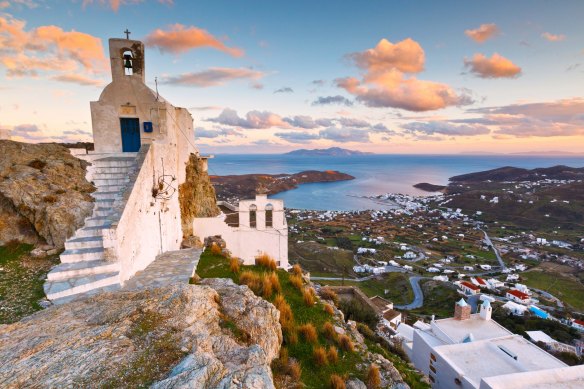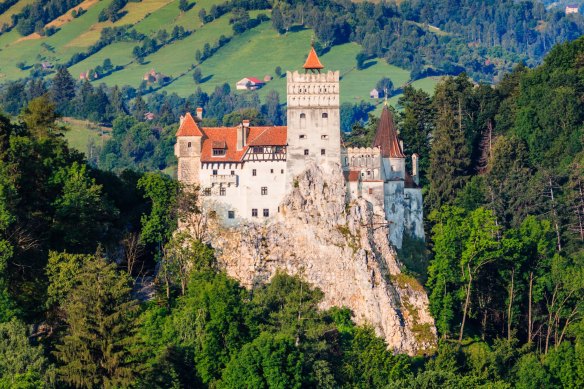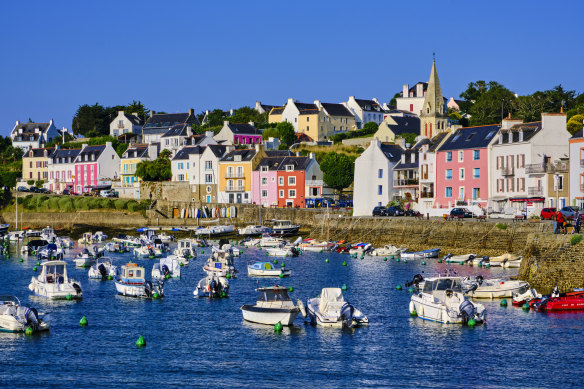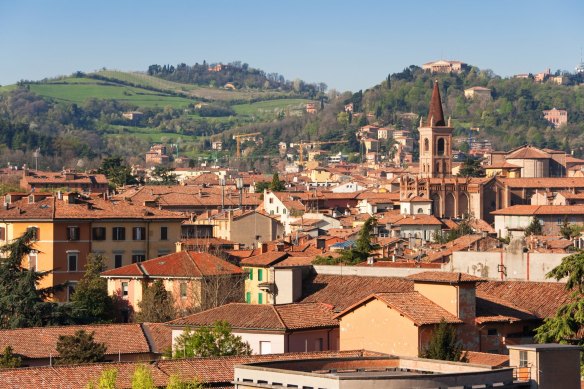
Food lovers won’t be disappointed, either. The classic local dish is fabada asturiana, a casserole of beans, pork, sausage, saffron and spices. Asturias is the cheese capital of Spain thanks to milk from cows fed on high summer pastures. Caldereta, a stew of seafood, parsley, fresh tomato, white wine and a dash of cognac, takes the taste buds out for a dance. Serve it with a dip at one of the beaches that line the 350-kilometre-long Costa Verde and you’ll nail a quintessential Spanish experience.
Sifnos, Serifos and Milos, Greece

Serifos island in Greece. The island Sifnos can be seen in the distnce. Credit: iStock
Nowhere does sunshine and simple pleasures quite like the Cyclades. While the Insta-crowd will be packing themselves into Santorini and Mykonos, it might be worth turning your attention to some of the archipelago’s less strident glories.
In the western Cyclades, Serifos, the home of the mythical cave of the Cyclops, is craggy and austere, its lack of development a reminder of how the Greek Islands used to be. Chora, the capital, is a cluster of sugar-cube houses crowning a small mountain overlooking the sea, while the centrepiece of Livadi, the port town, is Yacht Club Serifos, a simple waterfront bar popular at sunset.
Another option is the tiny gem of Sifnos, with its ruined Venetian castle, blue-domed churches and narrow stepped streets. And at the southern end of the Cyclades is the moonscape island of Milos, formed around a caldera and famous as the island where the statue of Venus de Milo was uncovered. If you’re after serenity, beaches accessible only by boat and local restaurants where the menu depends on what the fishermen just caught, Milos fits like a glove.
Transylvania, Romania

Bran castle found in the town of Brasov in Transylvania, Romania. Credit: Carmen Gabriela Filip / Alamy Stock Photo
Cradled within the crescent formed by the Eastern Carpathians and the Transylvanian Alps, Transylvania is better known as fiction than fact, yet the reality of this needs no embroidery. Transylvania is still dominated by hilltop citadels, palaces and Saxon fortified churches. In its craggy mountains, shepherds guard their flocks from wolves and eagles, in pastures sprigged with wildflowers that have disappeared from other parts of Europe.
Even its folklore – werewolves, witches and, inescapably, Count Dracula, based on a real and chilling 15th-century prince known as Vlad the Impaler – belongs to the Middle Ages. Sighisoara, the citadel where Vlad was born, has seen invading armies, plagues and fires yet remains a near-perfect example of a medieval town, a compact tangle of battlements and half-timbered houses and cobbled lanes that spiral up the hillside.
Endowed with palaces, great squares, fountains and opulent civic buildings, the southern Transylvanian cities of Brasov and Sibiu prospered on the trade flowing between the Ottoman Empire and Europe. Brasov’s Black Church is hung with Ottoman carpets donated by merchants in thanks for their safe passage. The Transylvanian countryside turns back the pages of the history book. Horse-drawn wagons lumber through muddy villages where the houses huddle along the main street, some crowned with stork nests, and in the fields, scarved women herd goats.
Belle-Île-en-Mer, France

Belle-Ile-en-mer, France.Credit: Getty Images
Lavishly green and rugged as a Breton fisherman’s face, Belle-Île-en-Mer – the “beautiful island in the sea”, just a 30-minute ferry ride off the coast of Brittany – packs in a suite of old-school summery pleasures now being rediscovered. It’s the France where nobody locks their front door, car keys stay in the ignition and children roam free.
Right now, the island is also flirting with foodie fame. At the pretty port of Le Palais, waterfront restaurants dish out bowls of steamed mussels with white wine, the pastel-fronted bistros that line Sauzon’s harbour are known for their bouillabaisse, and two former Lyon restaurateurs recently opened Maja, an eatery with a focus on local ingredients, to great acclaim.
Belle-Île-en-Mer was once home to an artists’ colony; Matisse, Monet and Australian John Peter Russell all painted here, while actor Sarah Bernhardt created a summer hideaway within a crumbling stone fort at Pointe des Poulains. The island maintains its artistic credentials with the Festival Lyrique International, a two-week opera event that draws some of the world’s megastars. The beaches are wild, the sea is bracing and there are some terrific clifftop hikes on well-maintained trails.
Emilia-Romagna, Italy

View of Bologna, Emilia-Romagna, Italy.Credit: SHUTTERSTOCK
Food is practically a religion in Italy, and Emilia-Romagna, the region just north of Tuscany, is the high temple of Italian gastronomy. This is the birthplace of balsamic vinegar, parmigiano reggiano, prosciutto, mortadella and the home of legendary chef Massimo Bottura’s Osteria Francescana, “a laboratory of ideas”. Providing balance, some of the world’s sexiest motor vehicles, including Ferraris, Maseratis, Lamborghinis and Ducatis, are also made here.
The region’s capital is Bologna, a handsome, terracotta-brick medieval city which gives its name to the world’s favourite spaghetti dish (although here it’s known as ragu alla bolognese). Robust yet refined is the order of the day; expect velvety sauces, creamy stuffed pasta dishes, sublime veal, charcuterie, cheeses and wines, with authentic cooking in the region’s osterie – small, traditional, family-operated taverns.
The cities of Parma, Modena and Ferrara offer an array of noble churches, regal palaces, galleries and festivals, while toothy fortresses and church spires dominate the rustic villages. Don’t miss Bologna’s indoor Mercato di Mezzo and in the evening, join the locals for the passeggiata around Piazza del Nettuno, named for the gigantic statue of Neptune at its heart.
Get the best of Sunday Life magazine delivered to your inbox every Sunday morning. Sign up here for our free newsletter.




























